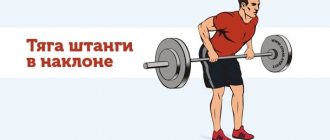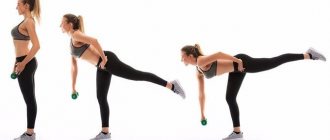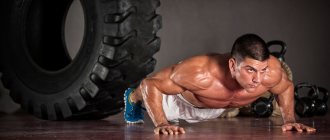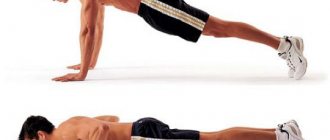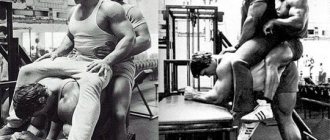Why is it important?
The exercise can be performed in different ways, but you must always breathe correctly. Why does the correct supply of air into the lungs and its exhalation have such a strong impact on the result? It’s very simple: proper breathing during training or competition in any sport is the key to good concentration and reaction of an athlete.
A person who moves air in and out of their lungs incorrectly during times of increased muscle strain and the body's special need for oxygen runs the risk of experiencing dizziness or even fainting.
The correct rhythm and timeliness of inhalation and exhalation have been trained for years, since before becoming acquainted with the science of proper breathing, most novice athletes do not breathe quite correctly, only intuitively guessing and adapting to their body.
Push-up workout
10-minute muscle pump
What:
This high-intensity, ten-minute, three-exercise circuit will flood your upper body muscles with blood to pump and completely fatigue your muscle fibers while keeping your heart rate up for both muscle-building and fat-loss effects.
How:
Do as many reps with your arms in a narrow position as you can, then rest for 20 seconds. Then do as many normal push-ups as possible and rest again for 20 seconds. Finally, do as many reps as possible with your arms in a wide stance and rest for 60 seconds. Repeat this pattern 4 times.
30 minute call
What:
This half-hour high-intensity workout will increase your body's muscular endurance by pumping up your muscles, resting, and then going through the fatigue process again.
How:
In the first and subsequent odd minutes, do ten normal push-ups and rest for the remainder of the minute. On even minutes, do ten reps of a different variation for your shoulders or triceps, and rest for the remainder of the minute. This way, you will do a total of 300 push-ups in just 30 minutes, which will help improve muscle strength and endurance. If ten repetitions seems easy to you, do 12-15 repetitions every minute.
Kinds
The horizontal bar has always been and remains a popular tool for developing the muscles of the upper shoulder girdle. Many modifications of horizontal bars have led to the emergence of “2 in 1 horizontal bar-parallel bars” models. Many who purchase such equipment and begin to perform push-ups and pull-ups are unlikely to have an idea of how to breathe correctly during exercise.
When training at home, unfortunately, there is no experienced trainer nearby who can tell you how to fill and empty your lungs in a timely manner. In addition, you can position your body in different ways:
- vertically when doing push-ups from the wall;
- also vertically - on uneven bars;
- horizontally - from the floor.
In fact, there are many more varieties, but in practice the ones listed are the most common, since they are acceptable for any training.
Push-ups: how to breathe correctly
The condition of the athlete’s cardiovascular system will depend on how correct the breathing is during push-ups. If breathing techniques are impaired, there is a risk of serious health problems.
When it comes to how to breathe during push-ups, the main thing is to remember the correct pattern. We go down as we inhale, we go up as we exhale . Take the starting position required for push-ups: lower your body and inhale. Then you need to touch the floor with your chest. Then - make a jerk and exhale at this moment. This is where the exhalation and the greatest effort in the exercise will coincide. Continue doing push-ups, breathing at the same rhythm.
Such proper breathing during push-ups helps reduce the load on the body during the exercise. Its essence lies in the following:
- Inhalation - an increase in arterial and intrauterine pressure, which increases the load on the heart and blood vessels.
- The maximum load during the exercise is difficult for your body. If it is supplemented by inhalation, the consequences can be very dangerous. This is why we always exhale at the greatest tension. In addition, exhaling is an opportunity to better concentrate on what you are doing.
It would seem that everything is quite simple with how to breathe correctly when doing push-ups from the floor. However, many people make mistakes in breathing techniques. This is a combination of inhalation with maximum effort, in which the body receives a huge load, and also, as we have already said, holding the breath, which is fundamentally wrong. Many people think it’s easier this way: hold their breath and not think about when to inhale and when to exhale. However, “savings” of this nature leads to general weakness, lack of oxygen, microtrauma of cerebral vessels, and sometimes loss of consciousness. It is clear that all this affects the effectiveness of push-ups in an extremely negative way.
How to inhale and exhale correctly during push-ups?
When performing any strength exercises, it is recommended to release air from the lungs during maximum muscle tension, and let it in during the muscle relaxation phase. When performing an exercise on the uneven bars, the load on the arm muscles is more serious than when performing a gentle exercise on the wall.
The last option is democratic, since the load on the hands with this type of exercise can be easily adjusted due to different angles of inclination of the body relative to the wall. But the most popular and accessible method without the use of all kinds of devices using your own body weight is push-ups from the floor.
Regardless of the method, proper breathing will be the key to a later onset of fatigue and faster muscle recovery between repetitions and approaches. The more difficult it is to do push-ups, the deeper you have to inhale.
Maximum range of motion requires longer breath holding. In this case, it is more likely that the rhythm of the exercise itself organizes the sequence of breathing. It is almost impossible to make a mistake with the moment of the beginning of inhalation or exhalation, since the body intuitively suggests that the athlete’s body, contracting from muscular efforts, facilitates exhalation, and inhalation in this case would meet almost insurmountable resistance.
The athlete does not need to strictly regulate his breathing, because even if he makes a serious mistake and switches the phases of inhalation and exhalation, the negative consequences will not be clearly expressed or will not occur on the first approach. An inexperienced athlete will not immediately understand why he feels a little dizzy and his limbs feel heavy.
The main mistakes in the technique of classic push-ups
Elbows pointing to the sides
The arms should not be positioned in a “T” shape in relation to the torso. This angle will disable the triceps and chest muscles from working, distributing the main load on the biceps, which relatively quickly creates excess tension in the shoulders and shoulder joints.
You should also not lean your elbows against your torso. How to do it correctly - their location should be at an angle of 40 degrees relative to the body. This position uses the most muscles, which helps reduce unwanted tension in the joints. In other words, the arms in relation to the body should not be positioned in the form of the letter “T”, but in the form of an “arrow”.
Too wide hand placement
Placing your hands too far forward is a common mistake that can negatively affect your shoulder joints. To avoid incorrect technique, you should control the placement of your hands, which should be positioned clearly under the shoulders.
Raising the pelvis or bending the body
When doing push-ups, care should be taken to ensure that the entire body maintains a straight line from the shoulders to the feet. Incorrect technique – protrusion or collapse of the pelvis
While performing the exercise, it is necessary to maintain tension so that the correct position is maintained. The pelvis should be slightly curled, the abs tense, and the lumbar region should remain flat. A straight back is the main condition for correct technique. Deflections are unacceptable, as this provokes an unwanted load on the spine.
Insufficient range of motion
If it is difficult to perform exercises while maintaining the full amplitude due to physical unpreparedness during push-ups, you should replace the classic version of the exercise with simple variations (from the knees, against the wall). At the bottom, your arms must be bent at an angle of 90 degrees, only you can get the maximum benefit from the exercises.
Exhale correctly
The process of exhalation and the accompanying contraction of the lateral and abdominal muscles will add additional rigidity to your body, stabilize it and help tighten all the necessary muscles. An experienced athlete, without hesitation, uses proper breathing to his advantage while performing push-ups from parallel bars, from a wall or from the floor.
During impact push-ups from the floor, when the count goes even for one additional repetition, which ultimately contributes to an increase in the result, exhalation activates the release of additional adrenaline into the blood so that the body can cope with the critical load.
In addition, an athlete distorted by a grimace during such a shock press from the floor or from the uneven bars simply physically will not be able to inhale, since the body will reflexively react by relaxing and disorienting him.
Recommendations
Today there are many experts online who have never done push-ups, but are already giving advice. It is hardly wise to listen to their opinion. This won't lead to anything good. It should be noted that improper breathing has serious consequences. As a rule, this concerns the cardiovascular system.
The load on your body's motor increases significantly. Some athletes stop breathing during push-ups. As a result, the face turns very red, and capillaries may burst and the nose may bleed. But this is not the worst thing, since you can suddenly lose consciousness.
To prevent anything like this from happening to you, trust only trusted sources. Many coaches suggest using Soviet books on athletics and weightlifting for these purposes. They describe the technique of push-ups, indicate the speed, number of repetitions, and talk about breathing.
Don't hold your breath while training
Do not delay ventilation of the lungs in any of its phases while performing push-ups from the floor or from parallel bars. You need to clearly monitor the work of your lungs and not allow unconscious delays to affect the duration and quality of your workout.
It is also dangerous by increasing blood pressure in the internal organs. If you have to deal with involuntary breath-holding every now and then, this may indicate that the body is not ready to perform an exercise with such a load and (or) amplitude.
If we are talking about push-ups, then in such a case you should choose an exercise that suits your abilities and instead of push-ups from bars or the floor, start with push-ups from the wall. In this case, correct breathing is more likely, because the beginning of the inhalation or exhalation phase is easier to control when not all the body’s resources are used to bend or extend the arms.
Exercise and breathing
We have already figured out a little about the fact that an athlete’s breathing during push-ups depends on the technique of performing the exercises. But it is worth noting that this applies exclusively to frequency. The fact is that when performing any physical exercise, you need to find a breathing rhythm and stick to it until the end of the approach. The only exception is cardio exercise, where everything is somewhat more complicated.
Since breathing correctly when doing push-ups is extremely important, which we have also already dealt with, delays are not recommended. This applies to both heavy exercises, such as squats with a barbell, and lighter ones, such as push-ups with your own weight or weights. During the exercises, after you have taken the starting position, you need to concentrate. You probably know that you cannot talk or look around during push-ups. Why? The whole point is that breathing is lost.
Beginner mistakes
So, we discussed how to breathe correctly when doing push-ups, and now let's highlight the main mistakes that novice athletes make:
- Complete air retention;
- With insufficient endurance, the athlete begins to breathe chaotically;
- The wrong technique is to inhale with effort, exhale with relaxation. Just imagine a giant, heavy cabinet and try to move it. And at the same time, inhale oxygen deeply and smoothly. It's unlikely that you succeeded.
- Constant breathing through the mouth.
So, now the breathing technique for push-ups is now familiar to you, and you also know why it is so important to master it perfectly. We wish you new records and never stop there!

